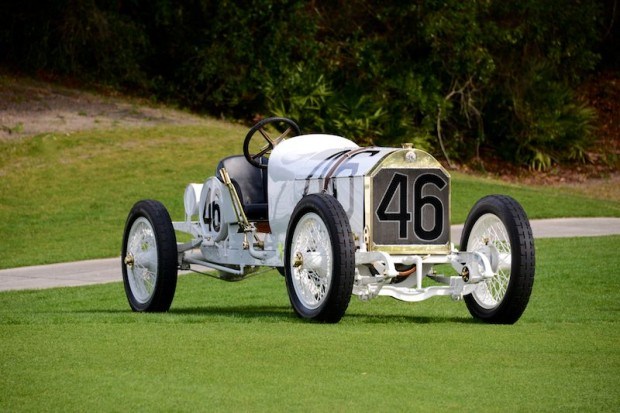1908 Prince Heinrich Two Seat Race Car

The descriptions of the Classic Cars in the Directory were partly generated or supplemented with the help of artificial intelligence (AI). The content may occasionally not always be entirely accurate or factually correct despite careful checking.
The Benz Prince Heinrich Two Seat Race car 1908 was a technical marvel of its time. It was initially designed by Ferdinand Porsche and named after Prince Heinrich of Prussia, who was an avid motor racing enthusiast. This car was built for endurance racing, and it competed in the 1908 Prince Heinrich Tour, where it finished first in its class.
The car is powered by a 105 horsepower 5.7-liter four-cylinder engine, which was quite an accomplishment back in 1908. The engine is water-cooled and employs a T-head design with two intake and two exhaust valves per cylinder. The car's drivetrain comprises a four-speed manual transmission that transfers power to the rear wheels through a live axle with semi-elliptic leaf springs. The car can reach a top speed of 90 mph, which was quite extraordinary for its time.
One of the most remarkable features of the Benz Prince Heinrich Two Seat Race car 1908 was its chassis. The car employs a pressed steel frame, which was an innovative design for the period. The chassis featured a ladder-like design with cross-members that made it strong and rigid, which was ideal for the rough roads of endurance racing.
The car's suspension system is based on semi-elliptic leaf springs, which were commonly used at the time. The front axle employs a transverse leaf spring while the rear axle features a live axle with semi-elliptic leaf springs. The car employs a mechanical brake system with brake shoes on the rear wheels.
The car's two-seat cockpit is sparsely equipped with only the necessary gauges and instruments to monitor the engine, such as a speedometer, oil pressure gauge, and water temperature gauge. The driver and the passenger sit side by side, and the cockpit is accessible through a low, narrow door on the car's side.
The car's aerodynamics were also an essential factor in its success. The car's bodywork was sleek and low, which helped reduce drag and increase top speed. The car employed a long, pointed nose that gave it a distinctive and recognizable appearance. The car's wheelbase was 2,950 mm, and the overall length was around 4,270 mm.
In conclusion, the Benz Prince Heinrich Two Seat Race car 1908 was a remarkable achievement in engineering for its period. The car's impressive 105-horsepower engine, innovative chassis design, and sleek aerodynamics made it a force to be reckoned with on the racetrack. It was, without a doubt, a car that showcased the early origins of automotive racing excellence.
Milestones
- Introduction: The Benz Prince Heinrich Two Seat Race car was introduced in 1908 as a high-performance racing vehicle designed to compete in the Prince Heinrich Touring Car Race. - Engine: The car was powered by a 75 horsepower engine, which was considered very powerful for the time. - Body: The body of the car was designed to be lightweight and aerodynamic, with a streamlined shape and low profile to reduce wind resistance. - Suspension: The Benz Prince Heinrich Two Seat Race car was equipped with a sophisticated suspension system that included adjustable shock absorbers and hydraulic brakes, which allowed for precise handling and improved stopping power. - Performance: The car was capable of reaching speeds of up to 90 mph and was considered one of the fastest vehicles of its time. - Success: The car was a great success in the Prince Heinrich Touring Car Race, winning the event in 1908 and setting several new speed records in the process. - Legacy: The Benz Prince Heinrich Two Seat Race car is considered a landmark in the history of automotive design and racing, and its technical innovations paved the way for future generations of high-performance vehicles.Technical
- The Benz Prince Heinrich was introduced in 1908 as a two-seat race car. - It was powered by a 6.8-liter inline six-cylinder engine. - The engine was capable of producing 80 horsepower at 2,250 rpm. - The car had a top speed of 120 km/h (75 mph). - It featured a four-speed manual transmission with a multi-plate clutch. - The car had a lightweight wooden frame and an aluminum panel body. - It had a wheelbase of 2,950 mm (116.1 in) and a track of 1,450 mm (57.1 in). - The brakes were mechanical, with large diameter drums on all four wheels. - The suspension was a solid front axle with leaf springs and a live rear axle on leaf springs. - The car had a fuel tank capacity of 120 liters (31.7 gallons). - The Benz Prince Heinrich was named after Prince Heinrich of Prussia, who was a renowned racing enthusiast and competed in several international racing events.